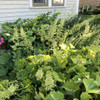

Please note your preferred ship date/week in the "Order Comments" section at checkout.
Otherwise, please allow 1-3 weeks to receive your order.
See the "Shipping" page under "Company Information" for our default ship dates based on hardiness zone.
We are unable to ship to any US Territories, AK, AZ, CA, CO, HI, ID, MT, NM, NV, OR, UT, WA, or WY
This robust coral bells is an excellent groundcover, with light green leaves and whitish flowers. It forms clumps of larger, hairy, evergreen or partially evergreen, light green/chartreuse colored leaves, and flowers in late summer through early fall.
Heat, humidity and drought tolerant plant. Deer and rabbit resistant perennial. The flowers attract specialized native bees and butterflies.
There is cultivar called 'Autumn Bride', first introduced by the Bluemount Nurseries of Monkton, Maryland, that has whiter flowers and is a vigorous variety with leaves and flowers that are larger than the norm. But in Europe, you'll find that Autumn Bride is used as the widely-accepted common English moniker. By any name, both plants are very similar and are excellent for the garden.
Blooming Time: August to September
Size: 1.5' tall (with flowers up to 3') x 1.5-2' wide
USDA Zones: 3 to 8
Culture: half or dappled shade (tolerates full sun in cooler areas or with consistent moisture), average soils, drained soils, preferably organic rich, but it is very adaptable
Moisture Needs: average to medium-dry
Origin: native to rocky slopes and open woodlands in the eastern USA (see the USDA distribution map)
Deer/Rabbit Resistant: yes / yes
Attracts Butterflies or Pollinators: yes / yes
Attracts Hummingbirds: no
Pot Size: square 3.5" pot x 5" deep
Plant combinations : Although this is a native plant, it is very showy and performs great in gardens - in flower beds, front gardens, half-shade areas, woodland edges, woodland gardens, low maintenance plantings, dry shade areas, or as a substitute for lawn grass. It is quite long-lived, and can be combined with many perennials. Looks well with fine structures like grassy leaves - Carex (sedges), Hakonechloa, narrow-leaved Hosta, Iris cristata (and the Asian counterparts) or Tradescantia and also fine leaves of ferns!
Other good companions can be also shorter cultivars of Amsonia, smaller Alchemilla, Anemone hupehensis (japonica), Aquilegia, Asarum, woodland Aster (Aster divaricatus etc.), Brunnera, Chelone lyonii, Dicentra, Disporum, Epimedium, Gallium odoratum, most of common hardy Geraniums, Helleborus, Heuchera and Heucherella, Geum, Lysimachia, Mellittis, Mukdenia, Nepeta subsessillis, Penstemon digitalis and calycosus (and hybrids), Phlox (x carolina and interspecific hybrids, Phlox divaricata, Phlox stolonifera, Phlox bifida), Podophyllum (better non spreading ones), Polemonium, Polygonatum, Primula, Pulmonaria, Sedum ternatum, Spigelia, Stachys officinalis hybrids, Stylophorum, Tiarella, Tricyrtis, Uvularia, Viola or Waldsteinia.
Picture copyright : US Perennials
This robust coral bells is an excellent groundcover, with light green leaves and whitish flowers. It forms clumps of larger, hairy, evergreen or partially evergreen, light green/chartreuse colored leaves, and flowers in late summer through early fall.
Heat, humidity and drought tolerant plant. Deer and rabbit resistant perennial. The flowers attract specialized native bees and butterflies.
There is cultivar called 'Autumn Bride', first introduced by the Bluemount Nurseries of Monkton, Maryland, that has whiter flowers and is a vigorous variety with leaves and flowers that are larger than the norm. But in Europe, you'll find that Autumn Bride is used as the widely-accepted common English moniker. By any name, both plants are very similar and are excellent for the garden.
Blooming Time: August to September
Size: 1.5' tall (with flowers up to 3') x 1.5-2' wide
USDA Zones: 3 to 8
Culture: half or dappled shade (tolerates full sun in cooler areas or with consistent moisture), average soils, drained soils, preferably organic rich, but it is very adaptable
Moisture Needs: average to medium-dry
Origin: native to rocky slopes and open woodlands in the eastern USA (see the USDA distribution map)
Deer/Rabbit Resistant: yes / yes
Attracts Butterflies or Pollinators: yes / yes
Attracts Hummingbirds: no
Pot Size: square 3.5" pot x 5" deep
Plant combinations : Although this is a native plant, it is very showy and performs great in gardens - in flower beds, front gardens, half-shade areas, woodland edges, woodland gardens, low maintenance plantings, dry shade areas, or as a substitute for lawn grass. It is quite long-lived, and can be combined with many perennials. Looks well with fine structures like grassy leaves - Carex (sedges), Hakonechloa, narrow-leaved Hosta, Iris cristata (and the Asian counterparts) or Tradescantia and also fine leaves of ferns!
Other good companions can be also shorter cultivars of Amsonia, smaller Alchemilla, Anemone hupehensis (japonica), Aquilegia, Asarum, woodland Aster (Aster divaricatus etc.), Brunnera, Chelone lyonii, Dicentra, Disporum, Epimedium, Gallium odoratum, most of common hardy Geraniums, Helleborus, Heuchera and Heucherella, Geum, Lysimachia, Mellittis, Mukdenia, Nepeta subsessillis, Penstemon digitalis and calycosus (and hybrids), Phlox (x carolina and interspecific hybrids, Phlox divaricata, Phlox stolonifera, Phlox bifida), Podophyllum (better non spreading ones), Polemonium, Polygonatum, Primula, Pulmonaria, Sedum ternatum, Spigelia, Stachys officinalis hybrids, Stylophorum, Tiarella, Tricyrtis, Uvularia, Viola or Waldsteinia.
Picture copyright : US Perennials
